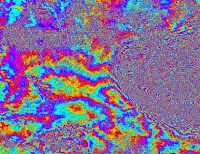 | |
| Photonics technologies are helping Nepal cope with recent devastating earthquakes. (Image: GlobalMedic) |
When massive, lethal earthquakes hit
Nepal earlier this spring, photonics technologies from satellites to
smartphones were employed to aid first responders and follow-on relief efforts.
Photonics is also helping to predict future earthquake locations and possibly
mitigate the potential for destruction, reported Rebecca Pool in the SPIE Newsroom. Some
highlights from the article:
1. High-resolution satellite imagery: Immediately after the first
earthquake, the Global Disaster Alert and Coordination System, a joint United
Nations and European Commission initiative, instructed the UN’s high-resolution
satellite imagery program, UNOSAT, and partners to start mapping the region. Images
of priority regions were swiftly integrated into a web map.
2. Interferograms: To pinpoint areas at greatest risk from future earthquakes, the European Space Agency has produced interferograms from data captured by its radar satellite Sentinel-1A. Imagery acquired before and after the earthquake has been combined to produce interference patterns that researchers use to quantify ground movement.
2. Interferograms: To pinpoint areas at greatest risk from future earthquakes, the European Space Agency has produced interferograms from data captured by its radar satellite Sentinel-1A. Imagery acquired before and after the earthquake has been combined to produce interference patterns that researchers use to quantify ground movement.
... plus seismic observations: Researchers from Caltech and the NASA
Jet Propulsion Lab (JPL) have combined satellite radar-imaging data with GPS
data and worldwide seismic observations to estimate the slippage of the fault
beneath Nepal. The research forms part of the Advanced Rapid Imaging and
Analysis project, providing tools and data for relief groups.
4. UAV-captured photo and video: Images from drones -- unmanned aerial vehicles (UAVs) -- were among the first to reveal post-earthquake
devastation and have helped responders pinpoint where aid is needed. Aeryon
Labs has supported GlobalMedic by supplying three small unmanned aerial systems
(sUASs) and a flight engineer to capture aerial photography and live
videography for detailed mapping of disaster zones. Infrared cameras can capture
images closer to the ground than satellites or manned aircraft, with operators
able to locate a human face some 300m away.
5. Low-power microwave radar: A novel search-and-rescue technology
dubbed FINDER -- Finding Individuals for Disaster and Emergency Response --
located four men trapped under some ten feet of rubble. Under development by
the U.S. Department of Homeland Security Science and Technology Directorate and
NASA JPL, FINDER uses low-power microwave radar to detect small movements from
breathing and heartbeats of buried victims.
6. Crowdsourced image data: Crowdsourcing has played a massive
part in recovery and rescue missions as well. As part of its relief efforts, commercial
satellite operator DigitalGlobe activated Tomnod, a crowdsourcing platform that
has allowed online volunteers to pore over satellite images, comparing new
images with old, and to tag damaged infrastructure.
More than 30,000 volunteers have
used the platform since the first Nepal earthquake, said DigitalGlobe's
Georgios Ouzounis. Thousands of damaged roads, buildings and areas of major destruction
have been catalogued. Relief groups have been able to target areas with the
largest number of survivors in need of food, water, tents and medical supplies.
7. Smartphone app: UNOSAT has developed a free
smartphone app called UN-ASIGN that automatically uploads photos taken by
volunteers to the organisation's web-maps. In Nepal, volunteer images have
validated satellite imagery and provided accurate details on damage in specific
locations.
Read more about photonics technology being used by responders and aid teams in Nepal and see more images, on the SPIE Newsroom.



Patanjali Yog Peeth Nepal Gives his supports for Nepal earthquake victims.For More Information Please visit my site:-Nepal earthquake help
ReplyDelete